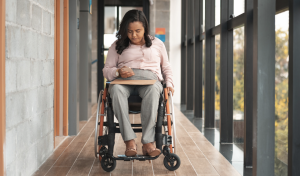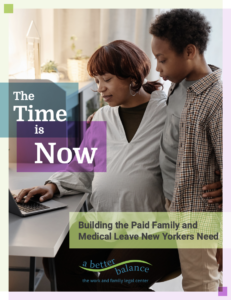The Time Is Now
Building the Paid Family and Medical Leave New Yorkers Need
By Meghan Racklin and Molly Weston Williamson, with contribution from Sherry Leiwant, Dina Bakst, Jared Make, Cassandra Gomez, Moriah Engelberg, and Jesse Workman.
Special thanks to Juliana Chang
Updated January 2025
Executive Summary
In 2016, New York passed its paid family leave law, building on the decades-old temporary disability leave program. Together, the paid family leave and temporary disability insurance law constitutes New York’s paid family and medical leave program. But while the passage of paid family leave was groundbreaking, New York’s paid medical leave remains woefully inadequate and, in the nine years since passage of the paid family leave law, many other states have surpassed New York by passing stronger paid family and medical leave laws. New Yorkers deserve a modern, comprehensive paid family and medical leave program. The groundwork for such a program exists. New York must build on that existing groundwork to create a program that meets New Yorkers’ needs.
Key Updates Needed to New York’s Paid Family and Medical Leave Program
With a few key updates, New York’s paid family and medical leave program can better meet the needs of New Yorkers and can once again stand amongst the strongest programs in the country. Specifically, New York’s existing program must be updated by:
- Raising benefit rates to a level that works for all workers, including eliminating the cap on benefits for one’s own health, which has been stuck at $170 per week since 1989
- Protecting workers’ jobs during medical leave so they can take time off to care for themselves without risking their economic stability
- Ensuring workers can take intermittent leave for their own serious health condition (for example, to attend chemotherapy appointments or address chronic pain)
In 2024, the New York State Senate approved legislation that would modernize Temporary Disability Insurance through these fundamental changes. In 2025, the State should get the job done and ensure that New York’s paid family and medical leave program is accessible, equitable, and unified.
A Better Balance and partners across the State are continuing to highlight other reforms – across both temporary disability insurance and paid family leave—that would ensure New York’s paid family and medical leave program meets the needs of all New Yorkers:
- Shifting from a flat wage replacement level (where benefits are a percentage of average weekly wages up to a cap) to progressive wage replacement, in which lower-income workers can receive a higher overall percentage of their wages
- Creating portable paid leave benefits and covering the unemployed and non-standard workers to account for the changing nature of work
- Ensuring that all workers can care for their loved ones, including chosen family

Who These Updates Will Help
Strengthening and updating New York’s paid family and medical leave program will benefit all New Yorkers. Eventually, everyone has their own health needs or a caregiving need—whether it be recovery from surgery, supporting a sick parent, or caring for a new child. Ensuring that New York has a strong program that supports all workers when they need time off to care for themselves or a loved one, and enables them to do so without sacrificing their economic security, gives everyone the support and security they need. These key improvements will also be especially helpful to certain communities who are disproportionately impacted by the current deficiencies in the program, including:
- Women in New York. Nearly 30% of claims for benefits for one’s own serious health condition in New York are based on pregnancy-related needs, including recovery from childbirth. Yet those benefits—for a population that also takes on the majority of caregiving labor—are woefully inadequate and lack basic job protection.
- In particular, these key updates are a crucial means of addressing the Black maternal health crisis. Workplace supports are one critical facet to the myriad systemic solutions needed. For instance, Black workers are more likely to be terminated after taking leave, leaving them particularly vulnerable in the absence of job protection. New York must strengthen its program to ensure that it can truly support Black New Yorkers in taking time off from work to keep themselves and their pregnancies safe and healthy.
- New Yorkers with disabilities. Nearly 1 in 5 New Yorkers have a disability and many more care for a loved one with a disability. Without a modern paid family and medical leave program, millions of New Yorkers with a disability and caring for a loved one with a disability face systemic disadvantages that lead them to be disproportionately represented in lower-wage work and unable to take poorly-paid time off work to manage their disability-related needs or care for their loved ones.
- New Yorkers affected by COVID‐19, especially longer‐term health consequences. Many New Yorkers have experienced long-term health consequences from COVID-19, with hundreds of thousands of New Yorkers estimated to be struggling with long COVID. New Yorkers need a modern paid family and medical leave program as they deal with the fallout of the pandemic and with long COVID.
- New Yorkers dealing with substance abuse. An average of 1,106,000 New Yorkers need, but do not receive, treatment for substance use disorder each year. Key treatment options, including in-patient and outpatient care, often require time off from work that many do not have access to. Those who are struggling with substance abuse need to be able to take time off from work for treatment and to manage their recovery.
- LGBTQ New Yorkers. LGBTQ households are more likely to live in poverty than their non- LGBTQ counterparts, and LGBTQ individuals—especially LGBTQ people of color—are more likely to report difficulty paying their usual household expenses. Older LGBTQ adults are also more likely to rely on chosen family for care support. For many transgender and non-binary workers, gender-affirming care is lifesaving, and yet, without a reliable paid medical leave program, often times out of reach. Transgender and non-binary workers need a livable paid leave program to recover from gender-affirming surgeries and other medical care. LGBTQ New Yorkers need a program that makes paid leave truly affordable and accessible for them.
- Veterans and military families. Veterans are often managing service-related disabilities. Post-9/11 veterans in particular have a 43% chance of having a service-connected mental or physical disability. At the same time, military spouses are especially likely to move between jobs due to relocation and to experience periods of unemployment due to relocation as a result of their loved one’s service, making it hard to meet the current onerous qualification requirements for paid family leave. Veterans and military families need a program that supports them in their service to our country.
This report explains these key changes and their impacts. New Yorkers have waited long enough for a paid family and medical leave program that truly works for them. The time to strengthen and update New York’s paid family and medical leave to create a program that meets New Yorkers’ needs is now.

